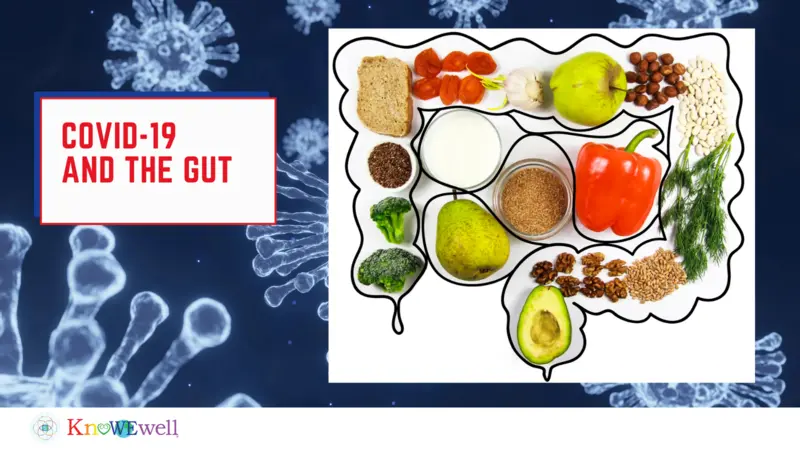

COVID-19

COVID-19
COVID-19 and the Gut
What’s the link between our gut, immunity, and COVID-19? KnoWEwell partner the Celiac Society of India convened a group of international experts by webinar to discuss the issue.
In the initial stages of the pandemic, only respiratory and cardiovascular symptoms of COVID-19 were recognized. As time passed, other symptoms came to light—anorexia, pale abdomen, vomiting, and diarrhea, among them. According to studies from China and Europe, these gastrointestinal (GI) symptoms antedated the symptoms of respiratory tract infection such as influenza.
There is concern that patients with GI symptoms seem to have a more severe form of the disease—and it appears family members are disproportionately affected. In addition, virus clearance took longer in patients with GI symptoms. Dr. Ajay Bhalla suggests use of a rectal swab, instead of a nasal swab, would be a better way to make policies for COVID-19 isolation.
Agreeing with Dr. Bhalla, Dr. Neerja Hajela added her insight from reports that people who have had COVID-19 in Wuhan, China (where the virus is believed to have originated), also had dysfunction of the gut. An interesting point: The viral RNA was found in the anal swab of these patients. The COVID-19 virus attacks the ace-II receptors and these receptors are predominantly found in the intestines and the respiratory tract or lungs. This suggests making a case for the gut-lung access.
People who have an abnormal microbiome or a problem with their gut are getting a more severe form of COVID-19.
“A link clearly seen now is that all those patients who are the so-called ‘susceptible group’—the elderly, obese, and diabetic, all these patients have also been reported to have dysbiosis,” mentioned Dr. Bhalla. It can be said that people who have an abnormal microbiome or a problem with their gut are getting a more severe form of COVID-19. People who are prone to dysbiosis produce a special extra protein, such as ciliated protein, which accounts for this.
Dr. Pankaj Verma talked about the increase in IgE [Immunoglobulin E, a type of antibody] and IL18 [Interleukin-18, a potent proinflammatory cytokine] levels in COVID patients, which occurs due to the increase in the number of pathogenic bacteria in the gut and the decline in the percentages of healthy bacteria such as bifidobacterial and lactobacillus. The number of unhealthy bacteria, like streptococcus, also increases as a result of which the cytokine storm [overactive immune response] is activated.
People with celiac disease are at higher risk of developing an infection.
Ultimately, the gut-lung access becomes more inflamed. These conditions suggest the intake of light meals, and avoidance of foods that are hard to digest. A liquid diet is recommended to help patients stay hydrated and compensate for loss of liquid due to diarrhea and vomiting. Probiotics and electrolyte solution to aid in recovery is recommended.
Gluten expert Dr. Tom O’Bryan brought to light an interesting fact. People with celiac disease are at higher risk of developing an infection, he said. The presence of comorbidities, such as high blood pressure and cardiovascular diseases—identified as an important predictor of morbidity associated with COVID-19—was more frequent in those with celiac disease than control subjects.
It is known that celiac patients tend to have a weaker immune system than non-celiac patients. In those with a weaker immune system, the IgA and secretory IgA is more at risk of not working well. Hence, those with celiac are not at greater risk of getting COVID-19, but if they do get infected, they’re at greater risk of developing problems.
A study by Dr. Alessio Fasano showed there was growing evidence that elements of gut permeability, immune response, and gut microbiome—together with genetic predisposition and exposure to environmental triggers—make the “perfect storm” for chronic inflammatory disease development. These are genetic vulnerability, environmental triggers, and altered microbiome (dysbiosis, intestinal permeability, systemic immune response).
Celiac patients tend to have a weaker immune system than non-celiac patients.
As shown by Dr. Fasano’s studies, the toll-like receptor IV activates a transient leaky gut—and the inflammation response of the immune system—whenever any harmful bacteria pass from stomach to small intestine. The reason wheat has a bad name is that gluten activates toll-like receptor IV, and this happens in anyone ingesting gluten. Eventually, this inflammation is no longer transient, and one doesn’t heal, irrespective of age.
Nutritionist Ishi Khosla recommended the half-plate rule with a change. First, fill the plate with vegetables, then add grains. She said that all colors need not be on the same plate. Instead, devote a complete meal to protective food. All our spices, vegetables, and fats give us polyphenols and phytonutrients that help in boosting our immunity. Chef Sanjeev Kapoor put forward alternatives for wheat such as ragi, bajra, and quinoa. He recommended trying a new grain every day instead of limiting oneself to wheat.
REFERENCES
Celiac Society of India. (2021, February). COVID-19 and the gut. Wheat Views, 2(1):5–6.


 By
By Collaborative Partner
Collaborative Partner 


